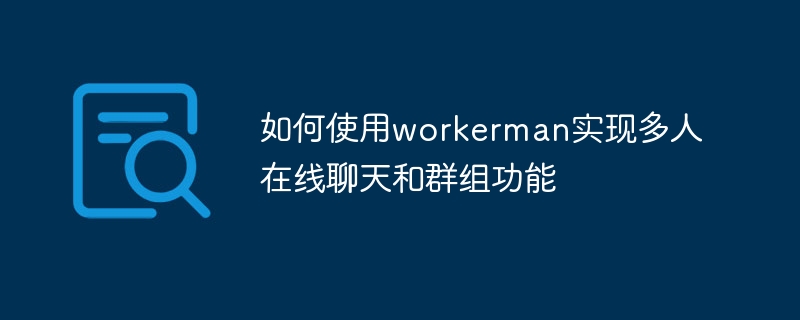
How to use Workerman to realize multi-person online chat and group functions
Introduction:
With the development of mobile Internet, people not only need to communicate with friends and family Instant messaging, but also hope to communicate and share information in groups. The use of existing chat tools, such as WeChat, QQ, etc., can meet the chat needs between individuals, but there are shortcomings in realizing multi-person online chat and group functions. The emergence of the Workerman framework provides us with a high-performance, scalable solution to implement multi-person online chat and group functions. This article will introduce how to use the workerman framework to implement multi-person online chat and group functions.
1. Introduction to workerman framework
Workerman is an open source high-performance PHP socket framework that supports multiple protocols such as TCP/UDP/Unix Socket. It has the advantages of high performance, low resource consumption, and easy expansion. Through Workerman, we can easily implement applications such as instant messaging, game servers, and the Internet of Things. Workerman provides a set of simple and easy-to-use APIs, allowing us to quickly develop high-performance, stable and reliable chat applications.
2. Basic function implementation
- Connection between client and server
In the workerman framework, we can use the WebSocket protocol to achieve two-way communication between the client and the server. WebSocket is a new technology in HTML5 that provides a way for full-duplex communication over a single TCP connection. The client can shake hands with the server through WebSocket to establish a persistent connection. The workerman framework provides a GatewayWorker class that can easily implement a WebSocket server.
- User Authentication and Identity Management
User authentication and identity management are indispensable when implementing multi-person online chat and group functions. We can authenticate users and assign unique user IDs when establishing a connection. The workerman framework provides relevant APIs that can implement simple user authentication and identity management, such as verifying the user's login status and permissions.
- Single chat and group chat
When the basic chat function is implemented, we can use workererman's event mechanism to handle client requests and message sending and receiving. When a client sends a message, the server can process it differently depending on the type of message. For example, if it is a private message sent to other users, the server can forward the message to the target user; if it is a message sent to a group, the server can forward the message to all users in the group.
- Message storage and offline push
In multi-person online chat and group functions, sometimes users are not online, and the server needs to store the user's messages and push them offline when the user is online. We can use the database to store the user's messages. When the user comes online, the server can read the user's offline messages from the database and push them. The workerman framework provides an API for asynchronous database operations, which can efficiently store and read messages.
3. Implementation of advanced functions
- User online status and offline detection
When implementing multi-person online chat and group functions, we can use heartbeat packets to Detect the user's online status. After the user establishes a connection with the server, the client can periodically send heartbeat packets to the server to maintain the connection. The server can determine the user's online status based on the interval of heartbeat packets. When the user does not send heartbeat packets for a long time, the server can mark the user as offline.
- Real-time message push
In multi-person online chat and group functions, we hope to be able to push messages to users in real time, instead of users needing to manually refresh the page to see new messages. We can use the websocket protocol provided by the workerman framework and the browser's WebSocket API to achieve real-time push of messages. The client can listen to the messages sent by the server through the WebSocket API and display them on the page in time.
- Picture and file transfer
In multi-person online chat and group functions, users may send media information such as pictures and files. We can use the file transfer function provided by the workerman framework to transfer pictures and files. When a user sends a picture or file, the server can perform related processing and store the picture or file in the specified directory. The client can view the corresponding image or file through a link or preview.
Conclusion:
Using the workererman framework can easily implement multi-person online chat and group functions. Through the implementation of basic functions and the expansion of advanced functions, we can develop high-performance, stable and reliable online chat and group applications. In actual development, we can customize and develop user interface, add friends, create groups, message notifications and other functions according to specific needs, thus making the chat application more rich and practical.
The above is the detailed content of How to use Workerman to implement multi-person online chat and group functions. For more information, please follow other related articles on the PHP Chinese website!






